MacMurchy, McIntosh and McArdle: a Wine Gang winner in Rioja
POSTED ON 14/12/2009I am afraid I have had a problem with the server, who has lost my material back to August. As a result, I am having to upload this blog, and articles and blogs back to August, again. So please bear with me, and I hope to have normal service resumed asap.
MacMurchy, McIntosh and McArdle: a Wine Gang winner in Rioja
On a bright autumn morning in Logroño in Rioja, I meet up with Barbara MacMurchy, winner of the Wine Gang’s competition, and her husband Ross. Now retired from her job with John Lewis in Bracknell, Barbara runs the local wine club in Hannington, where she puts on a tasting once a month for the club’s 40-odd members. Accompanied by Rob McIntosh, social networker extraordinaire and Vivanco’s PR man in the UK, we set off for Vivanco’s bodega and vineyards at the hill town of Briones in the heart of Rioja Alta, the craggy peaks of the Sierra Cantabria to the east and the more distant Sierra de le Demanda on the western side of Rioja’s vast amphitheatre of vines.
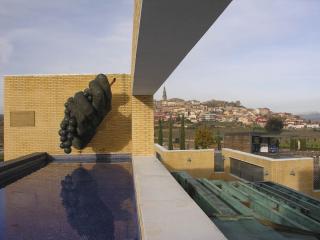 Vivanco, with the village of Briones in the background
Vivanco, with the village of Briones in the background
A modern circular temple to wine and wine culture designed by Jesús Marino Pascual, Dinastía Vivanco sits facing Briones with a Bacchus’s garden of 222 grape varieties in front. We meet Rafael Vivanco, 34-year old son of Pedro Vivanco Paracuello, whose brainchild the museum is. Rafael makes the wine and his brother Santiago, 36, oversees the museum, shop, bar, tasting room, conference centre and restaurant, which is not surprisingly Rioja’s biggest tourist attraction, with some 150,000 visitors a year from Spain and abroad. With so much of the complex below ground, it’s hard to grasp immediately just how extensive and indeed how magnificent this complex is, given that it includes the entire winery as well as all the other facilities.
On the day we arrive, they’re playing cheesy music à la Bing Crosby, but, as welcome as the strong espresso from the bar, a stirring, impromptu aria from a young visitor to the tasting room (jokes on the lines of ‘what if he’d had the reserva’ etc.) makes up for it. Once the affable Rob McArdle, marketing and PR director, has joined us, a caffeine-fuelled Rafael Vivanco gives us an introduction to the family history, the winery and Rioja (for the Vivanco story in more detail, see below).
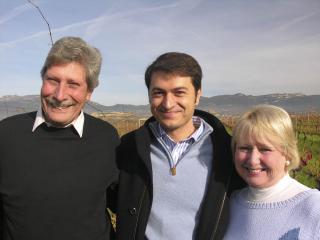 Ross, Rafael and Barbara
Ross, Rafael and Barbara
Rafael gives us a guided tour of the high-tech, modern winery (gravity fed, natch) which is spotlessly clean, airy and tidy, and then a tasting before lunch of the current range (see tasting notes below) and a barrel tasting to whet the appetite. By 3 pm, pangs of hunger are setting in big time, so we head for the restaurant, which looks east towards the distant hilltop village of San Vicente. The restaurant is run by Jon Zubeldia and Maribel Frades, previously at El Bulli and Arzak, and the food is excellent. After superb tapas including melt-in-the-mouth slices of jamon iberico and a memorable porcini and scrambled egg affair, almost everyone opts for the grilled lamb chops. I rather wish I had too judging from the satisfied oohs and aaahs but I go for the ‘sensible’ turbot for something light as we’re eating out that night at Taberna Herreria in Logroño. It doesn’t go quite as well with the delicious Mazuelo.
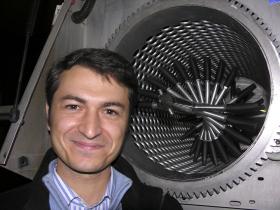 Rafa and de-stalker
Rafa and de-stalker
It’s 5 pm before we rise, replete, from the table. Just enough time for Rob McIntosh to give us a whirlwind tour (set aside half a day if you can) of its five beautifully rooms arranged over 9000 square metres. It’s a fantastic tour of historic wine artefacts and the arrangement of vineyard and winemaking equipment is such that it really does give you a sense of the history, tradition and culture of winemaking from ancient times right up to the present. The videos are very well done, the pièce de résistance however a valuable collection of paintings, sculptures, friezes, rare books and manuscripts along with wine artefacts that embody the creative spirit of wine. Just when you think you’re ready to surface for a restorative glass of Rioja, there’s a collection of 4,500 corkscrews to get your head around.
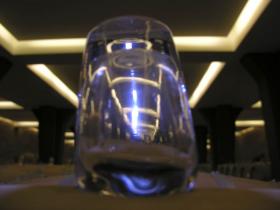 A bung in a barrel
A bung in a barrel
We had arrived in bright morning autumn sunshine and left in the darkness of a chilly, wintery evening, the lights of Briones twinkling like stars ahead of us. An appreciative Barbara was clearly captivated by the entire tour, as was her husband Ross. ‘The visit to Dinastía Vivanco Bodegas was wonderful’ she wrote later. ‘Rafael has a real passion for making his wines which are indeed excellent and the cellar very modern. The lunch and company were very enjoyable and the museum was a real unique look into the history of wine. All in all, everything about the day was just great’. I don’t suppose it’ll be long before she’s regaling the Hannington Wine Society with stories of her day out at Dinastía Vivanco.
Dinastía Vivanco
Museum of Wine Culture
Ctra. Nacional 232. Km 442
26330 Briones, La Rioja
Tel: +34 941 322 323
infomuseo@Dinastíavivanco.es
http://www.Dinastíavivanco.com/inicio.asp
Restaurant open 13.30 to 15.30 and 20.30 to 22.20
Closed Mondays and Sunday evenings
Museum open Tuesday – Sunday
Reservations 902-32-00-01 (from Spain) or to +34-941-322323
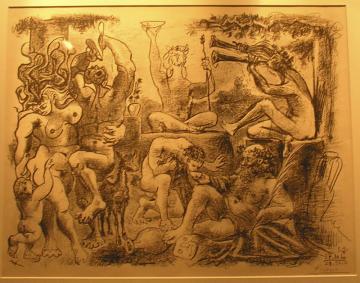 Pictures from a museum: Picasso Bacchanal
Pictures from a museum: Picasso Bacchanal
Dinastía Vinanco – Rafa’s Story
“Our family is from Rioja. My great grandfather, Pedro Vivanco Gonzalez, started out as a cosechero in 1915. In most families in Rioja there's always a member with a few hectares of vineyards, bringing in extra income from grapes. Even today, Rioja remains a very traditional area where people are attached to the land and they don't want to sell their vineyards. Roughly 80% of Rioja is still in the hands of the growers with around 50% of vineyards less than 1 hectare in size and only two or three vineyards of over 100 hectares.
A cosechero is a man who makes his own wine. What my great grandfather didn’t consume he sold. Only one of his sons, my grandfather Santiago, wanted to continue in wine, while the others emigrated to South America. Santiago married Felisa, who was very commercially minded and came from a family selling fruit and chickens in the local market. She was very much a trader, so together they opened a little wine 30 square metre shop in the old town of Logroño. When they sold out, they started to buy in wine from other bodegas and cosecheros, so much so that they opened a bigger wine shop, but keeping the original bodega in Alberite, 7 kilometres south of Logroño.
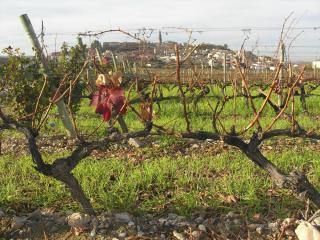 Briones from Vivanco's vineyard
Briones from Vivanco's vineyard
My father Pedro, their only son, loved working with his mother in the wine shop, and at the age of 20, seeing other bodegas growing and improving their wines, decided to study oenology at Requena near Valencia. After a couple of years, he returned to Rioja and decided not to work for others but to remain in the family business. He had a clear idea of the quality project he wanted to create in the future but to make the necessary income for that investment, he worked with other cosecheros and co-operatives in the region, buying, selling, ageing wines and bottling them.
Meanwhile, as a student in Requena, he fell in love with the culture of wine. At that time, people were paying you to get rid of the old clutter in their bodegas and my father started to collect what others were throwing out. It started with books, and later, viticulture and vinification equipment. My mother Angelica is a painter and with her artistic sensibility, became a strong influence on my father. They also travelled abroad looking at other projects and my father started to dream of creating a bodega with his own vineyards and a museum of wine culture to share his passion for collecting. Since we were children, my brother Santiago and I have shared in our father’s vision and embraced it.
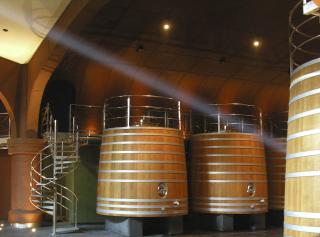 The finger of God
The finger of God
In 1985, my father chose this spot because he loved Briones, which had been virtually abandoned following the drift of people into the cities in search of work. He loved the landscape and the quality of the wine, which is in the heart of Rioja Alta close to Haro. Eventually, on 29 June 2004, the King of Spain, Juan Carlos I, came here to inaugurate Dinastía Vivanco, which is the only project bearing the family name. Our father still manages the company today, but he’s increasingly taking a back seat as he hands over the responsibility to Santiago and me.
I studied agronomy at Pamplona and spent a year in Reading in 1995 (hence his excellent English) before deciding to do a degree at Bordeaux in oenology. I worked in Bordeaux for the vintages of 1999 and 2000, first at a family winery in Sainte Croix du Mont, and then at Fleur de Bouard in Lalande de Pomerol with Hubert de Bouard of Château l’Angélus.
In Rioja Alta, after 15 - 20th October, it tends to be rainy and there's more clay in the spoil, so it can be difficult to get grapes to ripen as the temperature falls rapidly. Tempranillo begins to be harvested in Rioja in early September in Rioja Baja, while in Briones it doesn’t start until the 10th October, finishing by the 20th – a difference of 6 weeks in 85 kilometres. This was one of the reasons for investing in Rioja Baja in 2000. The climatic influence is more Mediterranean there with plenty of sunshine and freshness. Graciano and garnacha were planted along with tempranillo at a higher altitude of 500 – 700 metres compared to Rioja Alta’s 500 metres.
 more bungs than the Premiership
more bungs than the Premiership
80% of Rioja is tempranillo, with around 8% garnacha, then mazuelo at around 2 – 3%, while graciano is only 1.5% and the rest is white. We own around 430 hectares thanks to my father’s early decision to invest in vineyards. We believe in grapes other than tempranillo, like garnacha. We are planting maturana tinta and moristrell too. Rioja can be 100% of another variety as long as it’s made from one of the permitted grape varieties. Of Rioja’s 63,000 hectares, there are some 150 hectares of cabernet sauvignon and merlot, which are ‘experimental’ with mainly cabernet sauvignon and merlot. Most people here feel that although they were introduced in order to ‘enrich’ tempranillo, they can make better wines with traditional varieties rather than foreign grapes.
Most of us prefer to keep our identity, not introducing foreign grapes but saying let's improve our tempranillo with selections and clones and let's work better with traditional varieties, at least for reds. We have also authorised the introduction of indigenous grapes not authorised in the past, e.g. maturana tinta, and moristrell (nothing to do with monastrell). Whites are mainly viura with some garnacha blanca and malvasia but since sales were diminishing, we decided to introduce verdejo, sauvignon blanc and chardonnay along with white tempranillo, rivadavia and maturana blanca. In the whites, foreign grapes are permitted as long as they're less than 50% of the blend”.
 the colour of graciano
the colour of graciano
Dinastía Vivanco - The Wines
2008 Vivanco Viura Malvasia Rioja.
80% Viura, this is kept on lees for three months, bringing an attractive fresh aromatic apple and pear nose, appetisingly appley fruit, very fresh and crisp, with a soft texture, elegantly dry and refreshing. 88
2008 Vivanco Tempranillo Garnacha Rosado.
Mainly from Briones and Haro, this is salmon pink with pleasant fresh strawberry and savoury aromas, a fresh spritz, nice fresh raspberryish fruit quality, elegantly dry and juicily drinkable. 86.
2005 Dinastía Vivanco Crianza.
(Pure tempranillo from Briones and a bit from Haro, the aim to keep the wine fresh but with some oak-ageing complexity 16 months in barrel, 60% French, 40% American, 30% new oak). Smoky / spicy oak aromas, smoke and vanilla fruit, quite stylish, clean and juicy, some sweetness of blackcurrant a touch of chocolate, and a touch of bittersweet astringency, but overall nicely balanced. 88
2004 Dinastía Vivanco Reserva.
(90% tempranillo and 10% graciano, 24 months in barrel and a year in bottle. 50% new barrel, 70 – 80 % French) Good dark berry nose with a hint of spice and smoke, clean, fersh and juicy with supple tannins and a dark berry and blackcurrant fruit quality; supple and approachable fruit sweetness combined with a savoury fresh juicy acidity and well integrated oak, overall very well-balanced and deliciously drinkable with the structure to age for a good five years. 89+
2007 Colección Vivanco 4 Varietales.
(70% tempranillo, 15% graciano, 10% garnacha and 5% mazuelo. Each grape is vinified separately and blended after 20 months in barrel. 95% new oak. 14.5% alcohol) Very deep purple, intense dark berry fruits nose polished oak, intense rich dark berry fruit, good concentrated richness of flavour, with polished oak spice veneer, very supple and juicy, classic fresh Rioja Alta acidity; fine balance for such a powerful red. 91
2006 Colección Vivanco Parcelas de Garnacha.
(16 months new barrel. 15.5% alcohol) Very ripe and sweet, almost blackberry jam-like with and prune and syrup of figs and brown rice pudding top; rich, powerful and jammy, with the cooked character of overripe jam fruit with quite muscular tannics. 85
2007 Colección Vivanco Parcelas de Mazuelo.
(From Alberite and near Logroño, 16 months in barrel, 95% new oak. No clarification or filtration before bottling) Intensely aromatic, lovely and spicy, perfumed with a garriguey, sage-like character, ripe dark fruits, also tinged with herby garrigue, very nice supple tannins and juicy fresh acidity; very good concentration of intense dark fruits and lovely balance. 92
2006 Colección Vivanco Parcelas de Graciano.
(15% alcohol) Unbelievably inky purple opaque colour, very ripe dark fruits and spicy oak; powerful richly concentrated black fruits, fine tannins and savoury acidity; good intensity of flavour and richness, with notable astringency and firm tannins, saved by fresh, violety undertones. 90

